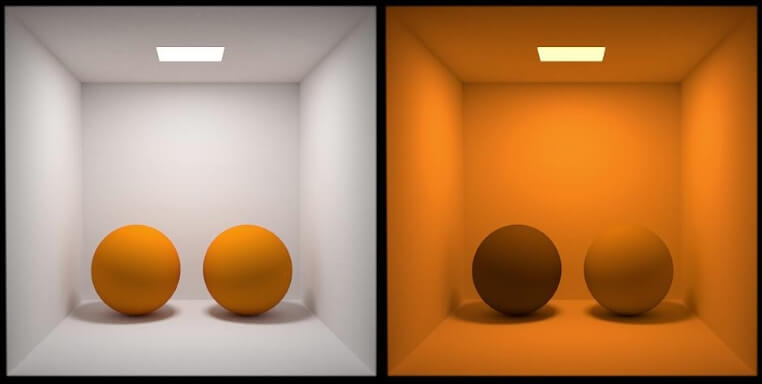Have you ever wondered if everyone else sees colour the same way as you do, or whether some people can see colours you can’t?
We are able to experience colour because we have three different types of cone photoreceptors in the eyes, which are all sensitive to different wavelengths. This is the case for most humans, but are there any exceptions?
Cones and Colours
Firstly, what are these cones that magically allow us to see colour? Well, cones are the receptors in our eyes which are used for daytime vision (we also have a different type of receptors known as rods—these are for night-time vision). The three types are known as: short, which are most sensitive to short-wave blue light; medium, which are most sensitive to green light; and long, which are most sensitive to long-wave red light. If you’ve ever wondered why the primary colours are red, green, and blue, this is why.
Having three types of cones, rather than just one, helps us to clarify the output caused by light hitting these receptors in the back of our eyes. This is because, to identify any particular colour, our brain not only needs to know the wavelength of the light (green vs blue), but also the intensity (light green vs dark green). Cones, however, are only able to respond in one way. They aren’t able to communicate both of these things at once, so having three different cones allows our brain to make an educated guess at what colour it is detecting.
To use an example of this, imagine you were looking at a lemon. A lemon is yellow (if you didn’t already know that), but what does it mean for something to be yellow in physics?
At its most basic, it means the object reflects light mostly in the green spectrum and a little in the red. When this reflected light hits our eyes, it causes our medium cones to respond strongly, our long cones to respond somewhat, and our short cones to barely respond at all (there will always be a small amount of stimulation since daylight includes all wavelengths of light). This mixture of an intense green signal mixed with a slight red signal will be interpreted by the complex systems of our brain to show the object as somewhere between green and red, also known as yellow.
Colour Matches
The ability of the brain and eyes to interpret these mixtures of light as a specific colour is known as colour matching. It was through these colour matches that Thomas Young first suggested that we have three different photoreceptors. All the way back in 1802, Young carried out experiments where he asked participants to adjust the relative intensities of lights until the combination matched the colour of a target light. From this, he found that at least three colours were always required to make an accurate match. It wasn’t until 1850, however, that the existence of the three cones was confirmed with physiological evidence. Hermann von Helmholtz identified the three photoreceptors by finding that each cone became active when exposed to a different wavelength of light.
Interested in studying Psychology or how the Human Brain works? Learn more about our Oxford summer courses, including our Neuroscience summer school for teens.
Colour Blindness
You’ve probably heard of colour blindness before: this is when people only have two colour receptors instead of the usual three. This is known as dichromacy. People with colour blindness are less able to distinguish between certain colours and will confuse colours that people with normal vision will not.
A good example of this for those of us without colour blindness is shown below, using lighting colour to simulate the same effect. You can see that the two spheres appear to be the same colour under bright white lighting, but are actually different colours when the lighting is changed to match the colour of either sphere.
This false colour matching is what is known as a metameric colour match. It occurs when our brain cannot infer enough of a difference between two colours—in this case because the contrast isn’t great enough under intense full-spectrum lighting—to interpret them as distinct from one another.
There are also cases of people who have only one type of cone: for example, a blue cone monochromacy. This leads to very poor colour discrimination abilities.
Very few people, however, have the most extreme form of colour blindness and lack all three cones. This is known as achromatopsia. People with this condition cannot see colour at all. Typically, for them, the world appears in shades of black, white and grey, dependant on the intensity of light their eyes detect.
There are also people who still have three cones but experience colour differently because one of their cones is sensitive to a different wavelength. This is known as abnormal trichromacy.
Extra Cones
Very few women (sorry guys) have what is known as tetrachromacy: four cones instead of the usual three. Does this mean that they can see colours we can’t? Not exactly, but it does mean that they are able to discriminate between more colours than normal due to having even fewer metameric colour matches than normal people. The spheres below, for example, to someone with tetrachromacy, may appear distinct (as they do on the right) even under intense full-spectrum lighting.

Why Do Humans Only Have 3 Colour Cones?
At this point, you may be wondering why we only have three cones; why not have more so that metameric colour matches become essentially impossible?
The reason for this is that adding more cones would mean we have less visual acuity. Visual acuity is the clarity of our vision: the ability to distinguish details and discern shapes. So, having three cones is a suitable compromise. It allows us both to distinguish between colours, as well as to have very good visual acuity.
What About Rods?
Like cones, these also have a different wavelength sensitivity, being most sensitive to a green-blue colour. Therefore, they have a different sensitivity to cones. However, we do not typically use rods and cones at the same time because rods are specialised for use in the dark as they are very sensitive to light (so they have a very low threshold for detecting light). Cones, on the other hand, are more suitable for use in the light as they are less sensitive.
So, when we go from light to dark, our eyes go through a process called dark adaption where we transition from using cones to rods. There is a point where both our rods and cones are in use which has a strange effect on our vision—this is known as the Purkinje shift. This basically causes your eyes wavelength sensitivity to shift, becoming more sensitive to blues than reds, which would make reds appear darker than normal.
Does Different Cultures See Different Colours?
What if even the names we give colours affected our perception of them? Some studies suggest the language you speak may actually affect what you can and can’t see. This is the Sapir-Whorf hypothesis. Different cultures give different names to different sections of the colour spectrum, and thus colour categories vary between cultures.
For example, the Greek language has a word for dark blue as well as a word for light blue, but no single word for the colour blue as a whole. Consequently, it was found that native Greek speakers are actually better at distinguishing a light blue shape on a dark blue background than a light green shape on a dark green background (there is one word for green in the Greek language). However, in German, where there is just a single word for blue and for green, there was no difference in discrimination between the two conditions.
So, it is clear that there are many factors which can cause people to see colour differently. Our colour perception is largely determined by our photoreceptors and how they allow us to distinguish between colours. However, it also seems that even people with normal vision may perceive colour differently, based on even something as small as the colour categories their language uses.
If you’re interested in learning more about this topic, you may find some of links below interesting.
More Resources on How the Human Eye Works
LiveScience.com article on Your Color Red Really Could Be My Blue
Sapiens.org article on Color Perception: Do You See What I See?
Expand your knowledge in science and biology, apply for our Oxford medicine summer school or online Biology & Life Sciences course for high school students.





